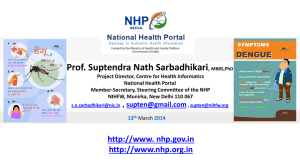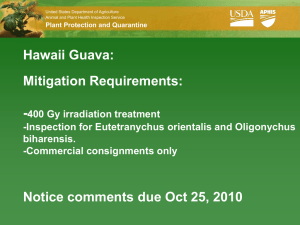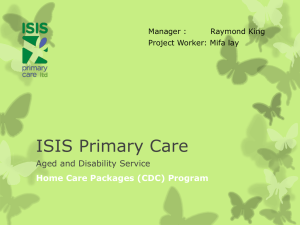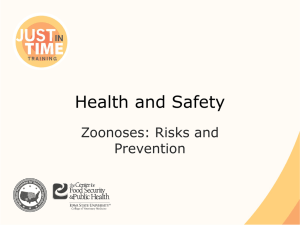Document
advertisement
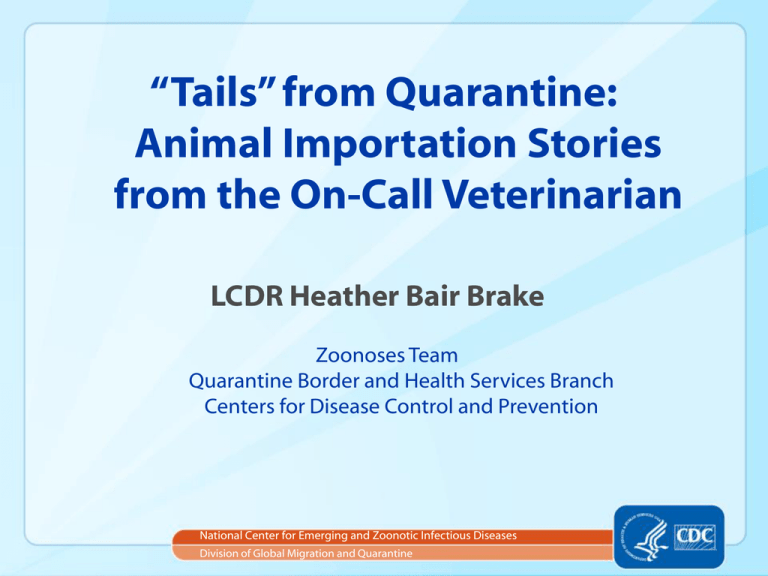
“Tails” from Quarantine: Animal Importation Stories from the On-Call Veterinarian LCDR Heather Bair Brake Zoonoses Team Quarantine Border and Health Services Branch Centers for Disease Control and Prevention National Center for Emerging and Zoonotic Infectious Diseases Division of Global Migration and Quarantine Overview Animal Importation Volume & purpose Regulatory authority CDC Zoonoses Team Tails from Quarantine “Bat on a Plane” “Rabid Rescue” “Cargo Ship Monkey” Live Animal Importation - 2006 U.S. Fish & Wildlife Service LEMIS Data 135,731 mammals 243,004 birds 1.5 million reptiles 4.8 million amphibians 228 million fish CDC Animal Data 287,000 dogs* 26,000 nonhuman primates** *McQuiston JH et al. Importation of Dogs into the United States: Risks from Rabies and Other Zoonotic Diseases. Zoonoses and Public Health, 2008: 55;421–426 **Bob Mullan, CDC Zoonoses Team, Personal Communication Reasons for Animal Importation Exhibition at zoos Education and research Scientific conservation programs Use as food and other products Tourism and immigration Commercial pet trade Personal pets Accidental Regulating Animals and Animal Products U.S. Department of Agriculture, Animal Plant Health Inspection Service (USDA/APHIS) Veterinary Services Animal Care Department of Interior U.S. Fish and Wildlife Service (USFWS) Department of Health and Human Services (DHHS) Centers for Disease Control and Prevention (CDC) Department of Homeland Security (DHS) Customs and Border Protection (CBP) DHHS, CDC, Division of Global Migration and Quarantine Primary focus is human health Authority to restrict importation of animals is related to potential health risks to humans 20 CDC Quarantine Stations at major ports Enforce DHHS statutory authority at ports of entry Depends heavily on federal partners at ports of entry CDC Regulatory Authority Importation of Animals and Animal Products 42 Code of Federal Regulations 71 – Foreign Quarantine Subpart F – Importations 71.51 – Dogs and cats 71.52 – Turtles, tortoises and terrapins 71.53 – Nonhuman primates 71.54 – Etiologic agents, hosts and vectors 71.56 – African rodents Subpart D – Health Measures at U.S. Ports: Communicable Diseases 71.32(b) – Persons, carriers, things Responding to a Public Health Threat 42 CFR 71.32(b) : Persons, Carriers, or Things When persons, carriers, or things on a carrier are suspected of being infected or contaminated, CDC may require detention , disinfection, disinfestation, fumigation, or other measures necessary to prevent the introduction, transmission, or spread of communicable diseases. Zoonoses Team Mission Prevent the introduction and spread of diseases of public health significance to humans from imported live animals or cargo containing infectious animal products IT’S A BIRD… IT’S A PLANE… NO. IT’S A BAT ON A PLANE! August 5, 2011 6:45 am flight from Madison, WI, to Atlanta, GA http://img.metro.co.uk/i/pix/2011/08/10/article-1312981208026-0D6121D500000578-530287_304x456.jpg Risk Assessment Agent of concern: Rabies Evaluation of passenger exposure status Contact with bat Sleeping during the flight Mental impairment Wounds of unknown origin Evaluation of crew/ground staff exposure Contact with bat History of bat infestation at airport Categorized into no, low, medium or high risk Passenger and Crew Risk Assessment Results Passengers Residents of 11 states Mean age: 41.2 years (range: 2 – 63 years) 47% female Crew 2 pilots 1 flight attendant 16 ground crew members Ground crew reported prior bat sightings No crew or pasengers reported contact with bat No postexposure prophylaxis (PEP) recommended Environmental Assessment No evidence of bats or bat droppings Airport animal incident record review 5 bats identified during 2011 Airplane doors kept open overnight Holes in the ceiling where jetway meets terminal Jetway canopy folds likely hiding place Recommendations Close holes in jetway ceilings Clean jetways during bat season Require mandatory employee training Custodial staff Baggage handlers THE CASE OF THE RABID RESCUE Operation Baghdad Pups Society for the Prevention of Cruelty to Animals International organizes rescues Rescue of soldiers’ pets from Iraq and Afghanistan Rescue initiated by one soldier’s plea to save his regiment’s mascot, Charlie Coming to America 2008, a shipment of 24 dogs and 2 cats arrived in United States from Iraq Housed in empty cargo warehouse at at Newark Liberty Airport Groomed Evaluated by veterinarian Two animals showed neurologic signs Cat – had small bite wound on its tail Dog – no obvious signs of bite wounds, no history of exposure to rabid animals http://blog.syracuse.com/pets/200 8/06/post_13.html Crusade for Crusader June 8: Crusader became wobbly and “snappy,” and developed diarrhea June 11: Euthanized following progressive weakness June 18: Tissue tested positive for rabies “Crusader” http://gothamist.com/2008/10/03 /rescued_dogs_from_iraq_promp t_rabie.php Follow-Up Investigation June 10: Remaining 23 dogs and one cat shipped to destinations in 16 states All animals were located within 2 weeks Because of exposure to rabid dog: Pets: Receive rabies booster 6 months of quarantine as determined by their state People: 13 received PEP International Pet Rescue Thousands of dogs and cats are rescued and brought into the United States yearly Many are rescued off the streets Creates health risks for both humans and animals Animal Rescue Team Taiwan Regulations for Importation CDC requirements: Dogs: – Must be healthy upon arrival AND – Must be accompanied by proof of valid rabies vaccination* OR be placed in confinement – Must meet state and local government requirements Cats: – Must be healthy upon arrival *Rabies vaccination is waived for dogs arriving from rabies-free countries. OPERATION SEA MONKEY National Center for Emerging and Zoonotic Infectious Diseases Division of Global Migration and Quarantine Event Time Line 3/24/2011 Ship departed in 3/29/2011 4/13/2011 CBP reported Ship due to Angola monkey loose arrive on cargo ship Houston, TX Pre-Event Planning Houston Quarantine Station Confirmed report and notified branch leadership and Z-team Joint agency planning began Initial Picture from Vessel Pre-Event Planning Two conditions for ship to dock 1) NHP is captured and secured in a crate or other container by crew before ship arrives 2) NHP is dead, double bagged and stored, preferably cold, before arrival Guidance developed for each scenario Minimize exposure to NHP Disinfect soiled areas on vessel The Response April 9, 2011: Captain reports NHP capture Boarding Plan and Responsibilities US Coast Guard and CBP Security and entry screenings Houston Quarantine Staff Crew health assessments Zoonoses Team Assess NHP health and crate integrity Inspect areas where NHP had access Response at Port of Houston Response at dock US Fish and Wildlife Vessel agent and legal representative CBP CDC Transport company NHP removed from vessel in crate and transported to registered importer facility NHP Assessment No fear of humans Possible pet Hybrid of species Physical Exam Performed under anesthesia Good body condition No significant findings Testing of NHP First tuberculin skin test placed one day after arrival Positive test NHP was euthanized Necropsy No significant findings on gross pathology Filovirus test was negative TB cultures, no growth Conclusions Risk to crew from NHP was minimal No evidence of active tuberculosis in NHP Reports indicated that NHP was outside most of the voyage Crew reported no close contact with NHP There is nowhere in the world from which we are remote and no one from whom we are disconnected PNAS, 2004 Preventing Disease Importation Partnership with state and local health departments Partnership with other federal agencies at U.S. ports of entry Open communication between CDC and importing organizations: International pet rescue groups Zoos Research institutions Acknowledgments CDC Quarantine Branch Emily Lankau – DGMQ EIS Officer Teal Bell – CSTE fellow Thomas George – Officer in Charge, Houston QS Zoonoses Team Adam Langer Gale Galland Bob Mullan Julie Sinclair Sheryl Shapiro
